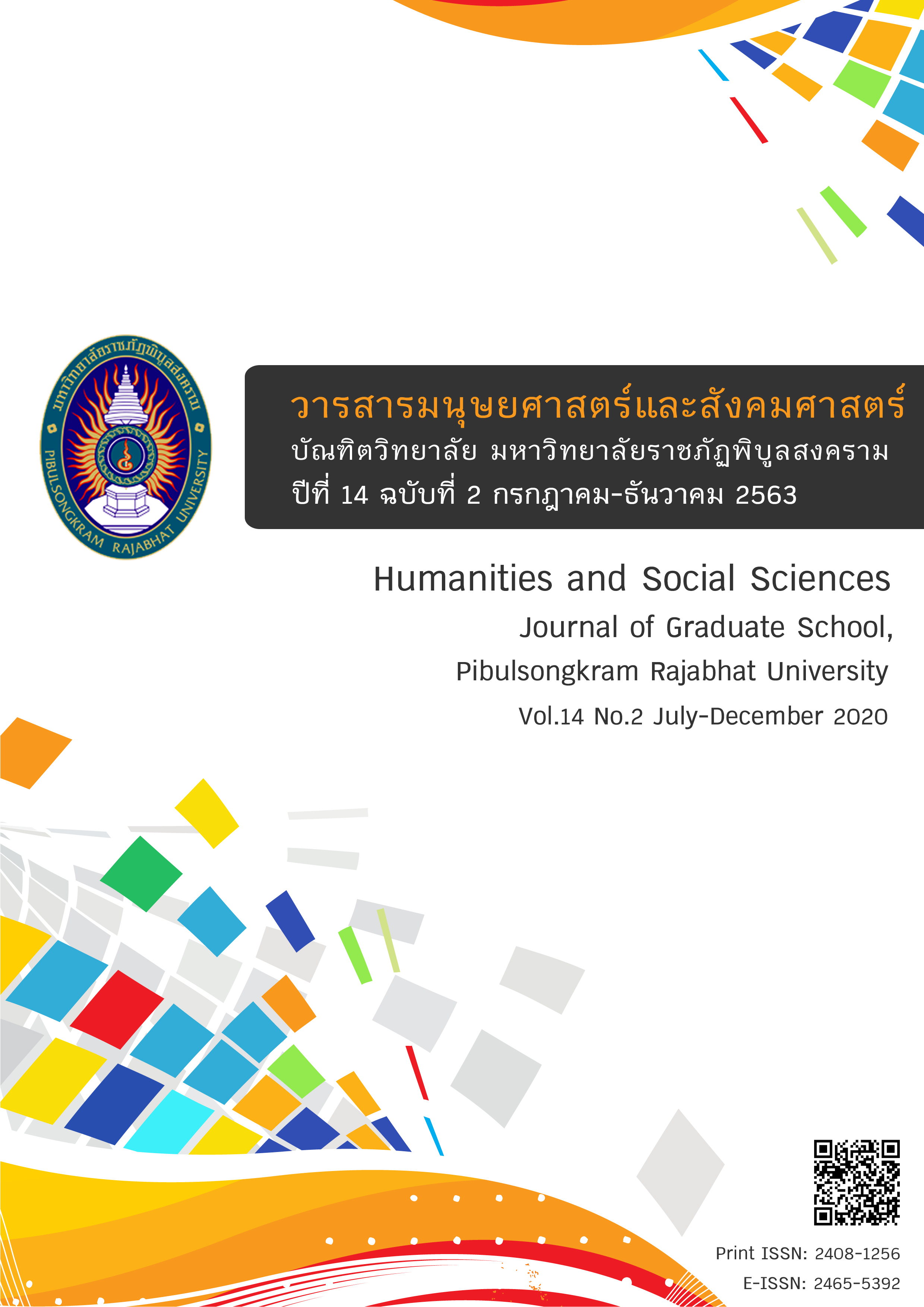The Effectiveness of Morphological Instruction Integrated with Semantic Mapping on English Vocabulary Learning of Thai Adult EFL Students
Keywords:
บทเรียนเรื่องหน่วยคำ, ผังสัมพันธ์ทางความหมาย, คำศัพท์ภาษาอังกฤษ, ประสิทธิภาพAbstract
The present study aimed at investigating the effectiveness of the morphological instruction integrated with semantic mapping on students’ relational, syntactic, and distributional awareness comparing to the no-strategy based instruction. The participants were sixty Thai adult EFL students at Thepsatri Rajabhat University. They were randomly put into control and experimental groups. The results revealed that the experimental group outperformed the control group in all aspects of derivational morphology. The results indicated that using morphological instruction integrated with semantic mapping had greater effect and contribution on students’ morphological awareness and English vocabulary development than the traditional one.
References
-able. (n.d.) In Macmillan Online Dictionary. Retrieved from https://www.macmillandictionary.com/dictionary/british/able_2?q=-able.
Ahmadi, S., & Kokabi, M. (2017). The Role of Lexical Inferencing and Morphological Instruction On EFL Learners’ Reading Comprehension Development. Iranian Journal of Applied Language Studies, 9(1), 1-32.
Amirjalili, F., & Jabbari, A. A. (2018). The impact of morphological instruction on morphological awareness and reading comprehension of EFL learners. Cogent Education, 5(1), 1-30.
Antonacci, P. (1991). Students Search for Meaning in the Text through Semantic Mapping. Social Education, 55(3), 34-46.
Brimo, D. (2016). Evaluating the Effectiveness of a Morphological Awareness Intervention: A Pilot Study. Communication Disorders Quarterly, 38(1), 35–45.
Carlisle, J. F. (2000). Awareness of the structure and meaning of morphologically complex words: Impact on reading. Reading and Writing, 12(3/4), 169–190.
Carlisle, J. F. (2003). Morphology Matters in Learning to Read: A Commentary. Reading Psychology, 24(3–4), 291–322.
Carlisle, J. F., & Nomanbhoy, D. M. (1993). Phonological and morphological awareness in first graders. Applied Psycholinguistics, 14(2), 177–195.
Chawwang, N. (2008). An Investigation of English Reading Problems of Thai 12th Grade Students in Nakhonratchasima Educational Regions 1,2,3 and 7 (Unpublished Master’s Thesis). Srinakharinwirot Unniversity, Bangkok. (in Thai)
Chen, X., & Schwartz, M. (2018). Morphological awareness and literacy in second language learners: A cross-language perspective. Reading and Writing, 31(8), 1685–1694.
Dilek, Y., & Yürük, N. (2013). Using Semantic Mapping Technique in Vocabulary Teaching at Pre-Intermediate Level. Procedia - Social and Behavioral Sciences, 70, 1531–1544.
Ebbers, S. (2017). Morphological awareness strategies for the general and special education classroom: A vehicle for vocabulary enhancement. Perspectives on Language and Literacy, 42(2), 29–34.
Hayashi, Y., & Murphy, V. (2011). An investigation of morphological awareness in Japanese learners of English. Language Learning Journal, 39(1), 105–120.
Heimlich, J., & Pittelman, S. (1986). Semantic Mapping: Classroom Applications. Newark, Delaware: International Reading Association.
Kieffer, M. J., & Lesaux, N. K. (2012). Development of morphological awareness and vocabulary knowledge in Spanish-speaking language minority learners: A parallel process latent growth curve model. Applied Psycholinguistics, 33(1), 23–54.
Lewis, M. (1993). The Lexical Approach. Hove: Language Teaching Publications.
Likert, R. (1967). New Patterns of Management. New York: McGraw-Hill.
McBride–Chang, C., Wagner, R. K., Muse, A., Chow, B. W.-Y., & Shu, H. (2005). The role of morphological awareness in children’s vocabulary acquisition in English. Applied Psycholinguistics, 26(3), 415–435.
Mochizuki, M., & Aizawa, K. (2000). An affix acquisition order for EFL learners: An exploratory study. System, 28(2), 291–304.
Morin, R. (2003). Derivational Morphological Analysis as a Strategy for Vocabulary Acquisition in Spanish. The Modern Language Journal, 87(2), 200–221.
Nagy, W., Berninger, V., Abbott, R., Vaughan, K., & Vermeulen, K. (2003). Relationship of Morphology and Other Language Skills to Literacy Skills in At-Risk Second-Grade Readers and At-Risk Fourth-Grade Writers. Journal of Educational Psychology, 95(4), 730–742.
Nagy, W. E., & Anderson, R. C. (1984). How Many Words Are There in Printed School English? Reading Research Quarterly, 19(3), 304-330.
Nation, I. S. P. (2001). Learning Vocabulary in Another Language. Cambridge: Cambridge University.
Noom-ura, S. (2013). English-Teaching Problems in Thailand and Thai Teachers’ Professional Development Needs. English Language Teaching, 6(11), 139-147.
Organable. (n.d.) In Cambridge Online Dictionary. Retrieved from https://dictionary.cambridge.org/spellcheck/english/?q=organable
Rovinelli, R., & Hambleton, R. (1977). On the use of content specialists in the assessment of criterion-referenced test item validity. Tijdschrift Voor Onderwijsresearch, 2(2), 49–60.
Schmitt, N. (2000). Vocabulary in Language Teaching. Cambridge: Cambridge University.
Schmitt, N., & Zimmerman, C. B. (2002). Derivative Word Forms: What Do Learners Know? TESOL Quarterly, 36(2), 145-169.
Shostak, J. (2003). The Value of Direct and Systematic Vocabulary Instruction. Sadlier-Oxford Professional Development Series, 7(1), 1–11.
Sritulanon, A. (2013). The Effects of Morphological Instruction on Reading Abilities of Low Proficiency Adult EFL Learners at a University in Thailand. Learn Journal: Language Education and Acquisition Research Network, 6(1), 50–67.
Tabatabaei, O., & Yakhabi, M. (2011). The Relationship between Morphological Awareness and Vocabulary Size of EFL Learners. English Language Teaching, 4(4), 262-273.
Varatharajoo, C., Asmawi, A. B., & Abedalaziz, M. (2015). Morphemic Analysis Awareness: Impact on ESL Students’ Vocabulary Learning Strategy. International Journal of Cognitive and Language Sciences, 9(9), 3263–3269.
Wikins, D. (1972). Linguistics in Language Teaching. London: Arnold.
Zahedi, Y., & Abdi, M. (2012). The Impact of Imagery Strategy on EFL Learners’ Vocabulary Learning. Procedia-Social and Behavioral Sciences, 69, 2264–2272.
Ziarani, M. M., & Mowlaie, B. (2014). Investigating the Effect of Morphology Instruction through Semantic Mapping on Vocabulary Learning of Iranian Intermediate EFL Learners. Journal of Language and Translation, 4(2), 49-59.
Zimmerman, K. (2005). Newly placed versus continuing students: Comparing vocabulary size. ESL Reporter, 38(1), 52–60.
Downloads
Published
How to Cite
Issue
Section
License
Any articles or comments appearing in the Journal of Humanities and Social Sciences, Rajabhat Phibulsongkram University, are the intellectual property of the authors, and do not necessarily reflect the views of the editorial board. Published articles are copyrighted by the Journal of Humanities and Social Sciences, Rajabhat Phibulsongkram University.









